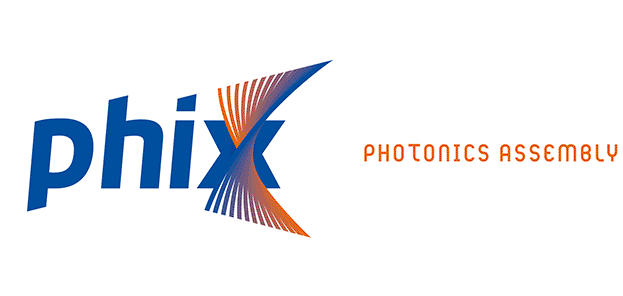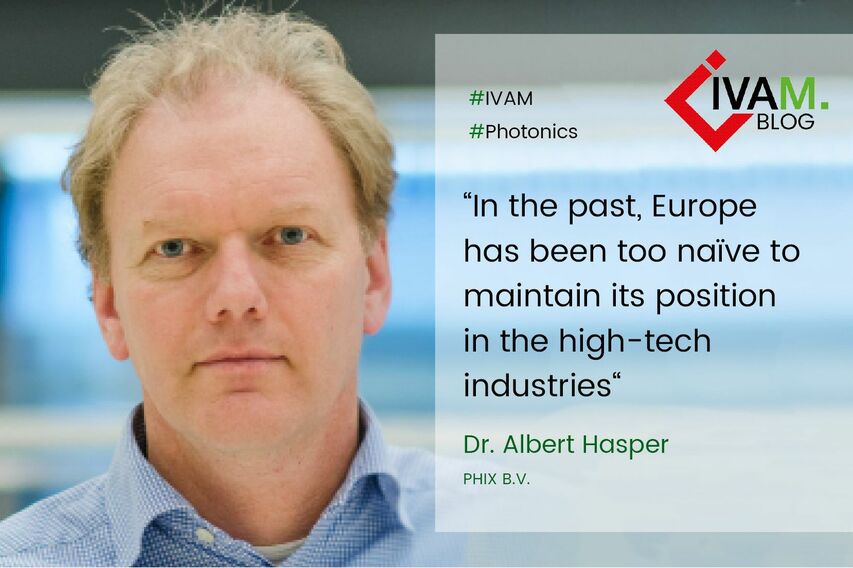Dr. Jana Schwarze of the International Microtechnology Business Network IVAM recently interviewed PHIX CEO Albert Hasper about the current challenges of the European photonics industry. The special occasion was the launch of the IVAM Focus Group Photonics, of which Albert is the chairperson, on June 29th 2021.
Q: Can you imagine why, for example, the semiconductor and solar industries have migrated to Asia?
“What I see from my view is that Semiconductor and Solar are being developed in Europe and America, but as soon as mass production was needed it shifted to Asia. This was solely pushed because of costs and the ability in Asia to scale up these industries in a rapid mode with the help of a lot of government support. What you see is that especially China is heavily investing in what they think is of strategic importance, and consequently they act accordingly with massive support from all directions.”
Q: Why does it make sense to keep the photonics industry in Europe? And what advantages does Europe offer compared to Asia?
“The next important technological development after solar and semiconductor is the photonic industry. Similar as for semiconductor and solar, Europe is very well positioned in the technology of the arena of Photonic Integrated Circuits (PICs). Compared to solar and semiconductor, the photonics industry is more diverse in its applications and is much less standardized and comes in all kinds of hybrid solutions. Furthermore, the volumes of the PICs will be much less than what we are used to in semiconductors. So, the volume is less, the mix is higher, and engineering of its applications and the fabrication, assembly and packaging of the devices is more diverse. In my opinion, this is a concept that is very well what we are good at in Europe. Moreover, the equipment industry to fabricate photonic chips is very well positioned in Europe, which gives the opportunity to excel if we work together and get the right support.”
Graphic courtesy of IVAM
Q: What must the governments (and possibly also Europe) do to ensure that the photonics industry remains located in Europe in the long term? Are companies like yours already getting the necessary support for this?
“Great question. In the past, Europe has been too naïve to maintain its position in the high-tech industries and, while abroad (mainly in China) massive support was given to develop the high-tech industry, Europe was counting on the autonomous growth of companies by themselves.
The result is that critical technologies were developed and scaled much faster abroad. In Asia by massive governmental support and in America this growth was driven by massive support from investments by VCs and investment companies. The result is that, due to the lack of money, in Europe we are lagging behind in these new technologies.”
Q: As a result of the Corona pandemic, the pharmaceutical industry, among others, has realized that a shift in production to the Asian region could have major disadvantages for Europe. To what extent could the Corona pandemic anchor the market for photonics more firmly in Europe?
“The Corona pandemic made it very clear how interactive the whole supply chain has become, and that the dependency on each other globally is much higher than we maybe want. We in Europe cannot act independently and for critical technologies we are relying on companies and supply chains we have no say in. This is an unwanted situation which we need to control. If we want to anchor new technologies, like the photonics industry, more firmly in Europe we need to work together to develop an ecosystem of companies where the total supply chain from development, fabrication and end product is available in Europe.
There are many critical applications in the photonics industry that we should keep control of, like:
- increasing the bandwidth of data- and telecommunication
- security and encryption of data
- healthcare
- autonomous systems
We as Europe need to lead this and control our destiny on these technologies without being dependent on technology or fabrication from outside Europe.”
About IVAM
The International Microtechnology Business Network IVAM is a network organization connecting professionals in the high-tech industry. The network, based in Dortmund in Germany, supports them in bringing innovative technologies and products to the market and to gain a competitive edge in international competition. IVAM unites people who are excited about key enabling technologies and the way these technologies shape our daily lives and our future. Albert Hasper is the chair person of the IVAM Focus Group Photonics. This interview was originally published on the IVAM blog.
Q: What has to be done in education and training to ensure that highly specialized professionals can continue to work in Europe in the future?
“From all things we can do, education is the most important factor we need. But be aware, if the education system is not backed up with an industry where we can get the benefit of these highly well-educated people, it is useless. So, education is one of the many things we need to do. If we can use these well-educated people in an industry and institutes that form a well-balanced photonics ecosystem, this leads to a strong supply chain that cannot be moved easily outside Europe.”
Q: In which direction do you think the photonics industry will develop?
“We are at the verge of this new industry and together with adjacent industries like the semiconductor and sensor industry we can develop many new applications that open completely new areas.
You can think of:
- Increase of bandwidth with less energy consumption in data- and telecom,
- quantum computing,
- sensing,
- autonomous driving,
- robotics,
- AR/VR mainstream applications, and many more we currently cannot think of.
These endless new and creative applications and products can help us and the world get more effective, safe, healthy, and also more fun, as these products make our lives more joyful.”
Written by Dr. Jana Schwarze, Project Manager of the IVAM Microtechnology Network.




